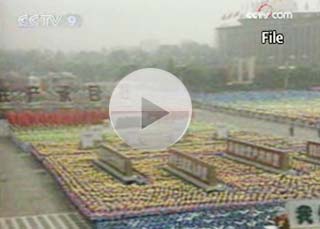------Program code: DO-090114-01779 (what's this?)
Source: CCTV.com
01-14-2009 08:57
 |
In the summer of 1984, people could be seen dressed in all manner of colors and styles. At the founding ceremony for the Beiijing Garment Association, Bo Yibo, Deputy Director of Central Advisory Committee, said in his speech, “To make our city more beautiful, to make our life more beautiful, we have to begin with making our clothes more beautiful.”
The previous year, of all the coupons people were so familiar with, clothing coupons were the first to be cancelled and with that the Chinese garment industry began to step out of the bondage of the planned economy and meet the demands of the market economy. One after another garment exhibitions took place, and locally-manufactured clothes featuring new and more adventurous designs began to appear.
 |
In October, a news story in a small corner of the Beijing Evening News caught the attention of many readers. It stated that the East Garment Modeling Art Performance Group was openly recruit ‘trainees for garment promotion art performances’, modeling became a new profession in China. The first group of models had appeared in Shanghai four years before. At the time the models were all amateurs selected from the factories of Shanghai Clothes Corporation, and whenever they had gone on tour to other parts of the country, they had needed to seek leave from their respective factories, since they were still considered everyday workers.
The East Garment Modeling Art Performance Group, however, was to recruit professional models. The criterion for female models was that they be no shorter than 1.68 meters, and in the case of male models, taller than 1.80 meters. Successful candidates would be modeling new designs and promoting sales, and the positions would be full-time.
The term “model”, however, was a very sensitive one, as some considered the profession of being one a kind of “spiritual pollutant”. In fact, such was the sensitivity that many models were reluctant to admit their faces had appeared on TV. According to Lu Guoqiong, head of East Garment Art Performance Group, “that’s why we avoided the term ‘model’. Instead we used the term ‘garment promotion art performance’, because we thought there wouldn’t be many people interested in doing this.”
To Lu Guoqiong’s surprise, more than 800 people turned up on the day set aside for auditions and the 200 application forms ran out. Many young people had come to apply secretly, without telling anyone in their family. In the end, Lu Guoqiong recruited 33 young men and women to form a modeling group that was soon performing all over China.
In 1984 dresses or shirts in red became the garment of choice among young people. Some people called this type of shirt “An Ran’s Shirt, An Ran being the main character in the teenager-oriented movie the Girl In Red, directed by female director Lu Xiaoya. The film, adapted from woman writer Tie Ning’s short story Red Shirt Without Buttons, told the story of a 16-year-old girl who loved to play football, wear a red shirt and hang out with a group of no-nonsense boys. At the beginning of China’s reform and opening-up, An Ran came to represent a young woman of independent thought.
In the film, An Ran offends her teacher Miss Wei with her directness and discloses the insincerity of the class monitor. In order to make An Ran a model student in the eyes of the teachers and students, her mother forbids her from hanging out with boys and her sister tells her to stop wearing her red shirt. An Ran becomes recognized as a model student after her sister secretly buys her teacher off, a result that makes An Ran more confused than ever.
The film presented a detailed depiction of a teenage girl who is innocent and confused about the unpredictable world of adults.
